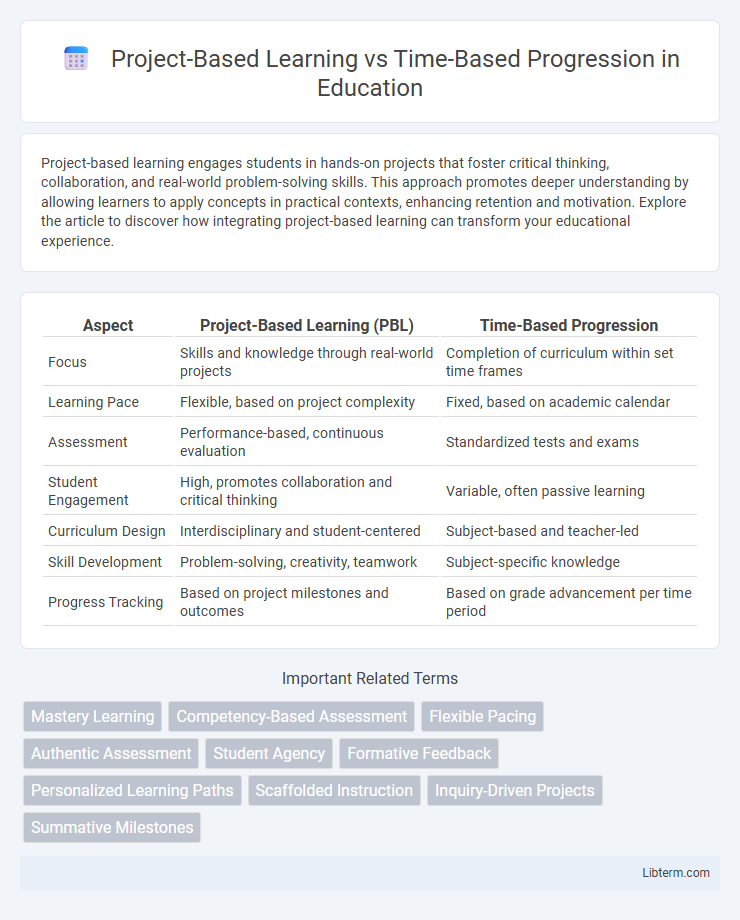Project-based learning engages students in hands-on projects that foster critical thinking, collaboration, and real-world problem-solving skills. This approach promotes deeper understanding by allowing learners to apply concepts in practical contexts, enhancing retention and motivation. Explore the article to discover how integrating project-based learning can transform your educational experience.
Table of Comparison
| Aspect | Project-Based Learning (PBL) | Time-Based Progression |
|---|---|---|
| Focus | Skills and knowledge through real-world projects | Completion of curriculum within set time frames |
| Learning Pace | Flexible, based on project complexity | Fixed, based on academic calendar |
| Assessment | Performance-based, continuous evaluation | Standardized tests and exams |
| Student Engagement | High, promotes collaboration and critical thinking | Variable, often passive learning |
| Curriculum Design | Interdisciplinary and student-centered | Subject-based and teacher-led |
| Skill Development | Problem-solving, creativity, teamwork | Subject-specific knowledge |
| Progress Tracking | Based on project milestones and outcomes | Based on grade advancement per time period |
Introduction to Project-Based Learning and Time-Based Progression
Project-Based Learning (PBL) centers on students acquiring knowledge and skills through engaging, real-world projects that promote critical thinking, collaboration, and application of concepts. Time-Based Progression relies on students advancing through curriculum at a fixed pace tied to set instructional periods rather than mastery or competency demonstrated through project outcomes. PBL enhances deeper learning by encouraging active exploration, whereas Time-Based Progression often emphasizes chronological advancement over individualized understanding.
Defining Project-Based Learning: Key Features
Project-Based Learning (PBL) centers on student-driven exploration of real-world problems through collaborative projects that emphasize critical thinking, creativity, and practical application of knowledge. Key features include interdisciplinary integration, authentic assessment through project outcomes, and flexible pacing tailored to individual learning progress rather than fixed time constraints. This approach contrasts with time-based progression by prioritizing mastery and deeper understanding over seat time and standardized testing schedules.
Understanding Time-Based Progression: Core Principles
Time-based progression centers on advancing students through educational content according to fixed schedules and age-related benchmarks, emphasizing uniform pacing and standardized assessments. This approach relies on structured curricula where progression is measured by seat time and periodic exams rather than mastery of skills. Core principles include predictable timelines, grade-level promotion, and a focus on chronological age as a primary determinant of educational advancement.
Comparing Learning Outcomes: PBL vs Traditional Methods
Project-Based Learning (PBL) enhances critical thinking, problem-solving, and collaboration skills by engaging students in real-world tasks, resulting in higher retention and deeper understanding compared to traditional time-based progression methods. Studies show that PBL students outperform peers in standardized assessments and exhibit greater motivation and adaptability. Conversely, time-based progression often emphasizes rote memorization and uniform pacing, which can limit personalized learning and practical skill development.
Engagement and Motivation in Both Approaches
Project-Based Learning fosters engagement by allowing students to interact with real-world challenges, enhancing motivation through hands-on collaboration and purpose-driven tasks. Time-Based Progression often relies on standardized pacing, which can limit individual enthusiasm and reduce intrinsic motivation due to less personalized learning experiences. Research indicates that project-based approaches significantly boost student engagement and motivation by aligning learning objectives with practical application and student interests.
Assessment Strategies: Performance vs Chronological Evaluation
Project-Based Learning assessment strategies emphasize performance metrics such as problem-solving skills, creativity, and collaboration within authentic tasks, enabling personalized feedback aligned with student growth. Time-Based Progression relies on chronological evaluation, measuring student achievement against fixed timelines and standardized benchmarks, often emphasizing memorization and test scores. Performance-based assessments better capture depth of understanding and real-world application, whereas chronological evaluation prioritizes uniformity and pace control.
Impact on Student Collaboration and Communication
Project-Based Learning (PBL) fosters enhanced student collaboration and communication by engaging learners in real-world tasks requiring teamwork and active dialogue, which develops critical interpersonal skills. In contrast, Time-Based Progression often leads to isolated learning experiences where students advance based on schedule rather than mastery or peer interaction, limiting opportunities for meaningful collaborative engagement. Research indicates that PBL environments significantly improve students' abilities to negotiate, articulate ideas clearly, and listen effectively within group settings.
Flexibility and Personalization in Learning Paths
Project-Based Learning offers significant flexibility by allowing students to engage with real-world problems at their own pace, fostering personalized learning paths tailored to individual interests and strengths. In contrast, Time-Based Progression follows a fixed schedule, often limiting personalization as all students advance uniformly regardless of mastery or engagement. This rigid structure can hinder adaptive learning strategies that address diverse learner needs and optimize educational outcomes.
Challenges and Solutions in Implementing Each Approach
Project-Based Learning (PBL) challenges include resource-intensive planning and varying student readiness, which can be addressed by integrating adaptive scaffolding and collaborative tools to support diverse learning paces. Time-Based Progression faces difficulties in accommodating individual mastery, often leading to knowledge gaps, solvable through formative assessments and personalized remediation strategies. Effective implementation requires balancing these approaches with institutional flexibility and continuous educator training to optimize learner outcomes.
Future Trends in Educational Models: PBL and Time-Based Progression
Project-Based Learning (PBL) emphasizes competency mastery through real-world problem-solving, driving personalized education and fostering critical skills like collaboration and creativity. Time-Based Progression adheres to fixed academic schedules, often limiting flexibility and individualized pacing in traditional classrooms. Future educational trends favor hybrid models combining PBL's experiential learning with adaptive time frameworks to enhance student engagement and optimize learning outcomes.
Project-Based Learning Infographic

 libterm.com
libterm.com